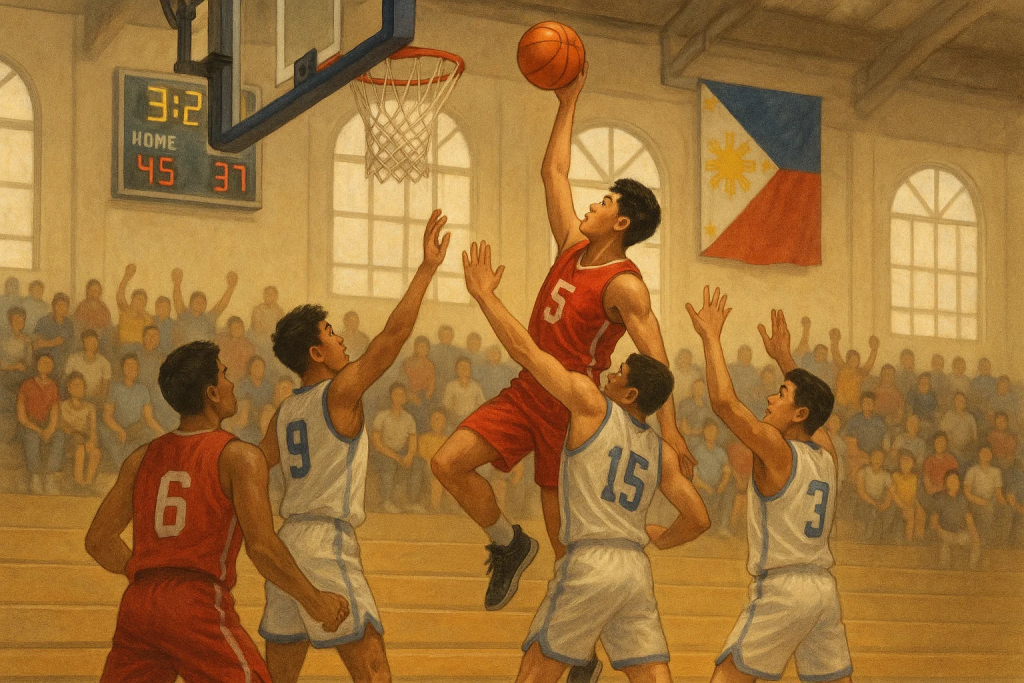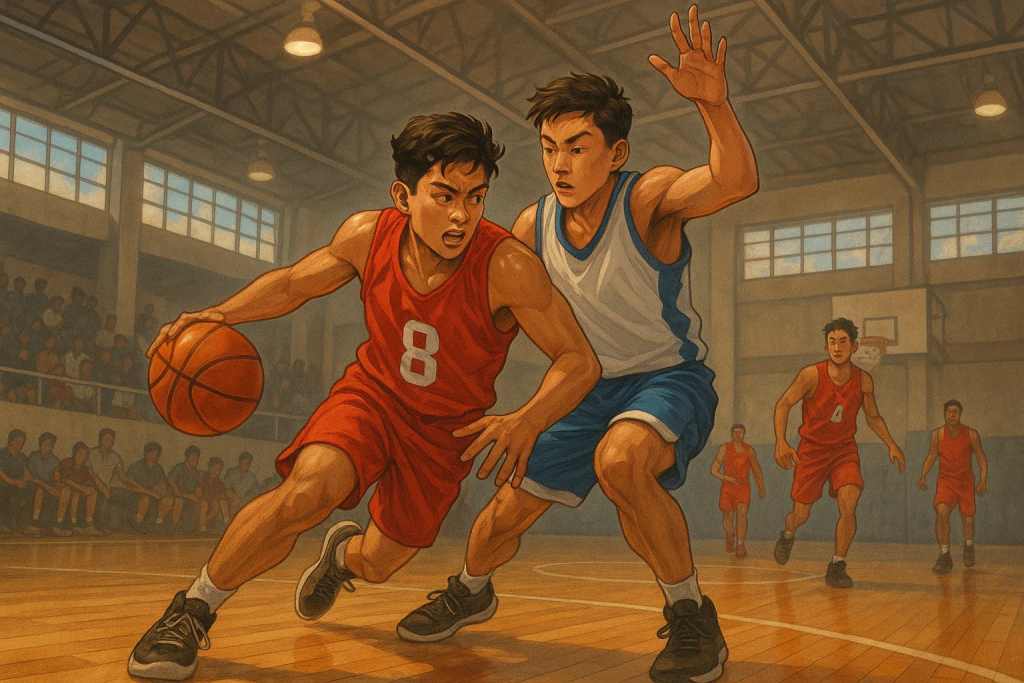Table of Contents
In this article, we will explore the vital role that high school basketball plays in developing young talent, the significance of high school leagues, and how this foundational level of the sport serves as the breeding ground for the next generation of Filipino basketball stars. We’ll also dive into the impact of high school basketball on the overall sports culture in the Philippines.
Basketball holds a special place in the hearts of Filipinos, with the sport being woven deeply into the culture of the country. From street courts to professional leagues, basketball has grown from a pastime to a passion. However, the roots of many of the Philippines’ top basketball players can be traced back to a place where dreams are first built—Philippine high school basketball.

1. The Importance of High School Basketball in the Philippines
1.1 Basketball as a National Passion
Basketball is not just a sport in the Philippines; it is a national obsession. It’s played in every corner of the country, from small barangays to major cities. The sport has long been the go-to pastime for Filipinos, offering entertainment, exercise, and a means of social connection. While professional basketball leagues like the PBA (Philippine Basketball Association) and the UAAP (University Athletic Association of the Philippines) get the lion’s share of attention, the foundation of Filipino basketball begins at the high school level.
High school basketball provides the critical first step in the development of players who will eventually compete at higher levels of the sport. It’s where young athletes hone their skills, learn teamwork, and experience the competitive drive that will take them to the next level. This stage of development is essential in producing the stars of tomorrow, whether they go on to play in the professional leagues or represent the Philippines on the international stage.
1.2 High School as the Starting Point for Future Professional Players
For many young Filipinos, high school basketball is the first serious competitive basketball environment they will encounter. It’s where they make the transition from recreational play to more structured, organized competition. The exposure to coaching, formal training, and team dynamics at this level is what helps many aspiring players understand what it takes to play professionally.
1.3 Role in Community Building
High school basketball is not just a training ground for athletes; it’s also a way to bring communities together. Local fans rally behind their high school teams, and school games often become community events. This connection strengthens the bond between the school and the local area, and it creates a sense of pride when a team succeeds. The excitement generated by high school basketball helps foster school spirit and is a source of pride for students, alumni, and local residents.

2. The Structure of High School Basketball Leagues
2.1 The UAAP and NCAA: Key High School Leagues
The two most prominent high school basketball leagues in the Philippines are the UAAP High School Division and the NCAA High School Division. These leagues have produced some of the country’s best-known basketball players, such as Kiefer Ravena, Ricci Rivero, and Kai Sotto, who all started their careers in high school basketball before making their way to the professional level.
- UAAP High School Division: The UAAP is one of the most prestigious athletic associations in the Philippines, and its high school division is a crucial platform for developing basketball talent. The league is made up of the country’s top universities, and the competition is fierce. Teams like Ateneo de Manila High School and De La Salle Zobel have been regular contenders, producing players who later thrive in the collegiate and professional ranks.
- NCAA High School Division: The NCAA (National Collegiate Athletic Association) has also long been home to top-tier high school basketball teams. Schools like San Beda High School and Letran College have consistently delivered strong performances, helping to showcase rising stars in the sport. The NCAA is well-known for its competitive atmosphere and strong basketball culture, making it a vital part of the high school basketball landscape.
Both leagues are integral to the development of young players and serve as the feeder systems for collegiate and professional basketball in the Philippines. These leagues give athletes the opportunity to compete at a high level, attract attention from scouts, and build a reputation in the basketball community.
2.2 School-Based Tournaments: The Heart of High School Basketball
Aside from the UAAP and NCAA, there are also many school-based tournaments that play a significant role in the development of high school basketball players. These tournaments, hosted by individual schools or regional basketball associations, give young players more opportunities to showcase their skills and compete. Notable tournaments include the SMB Youth Basketball League, the Batang PBA program, and other regional leagues.
These local tournaments allow young players to develop their craft and often serve as stepping stones to more prominent competitions, such as the UAAP and NCAA. They also provide an accessible platform for players who may not be part of major university systems but still have potential.
3. The Development of Young Basketball Players
3.1 Training and Coaching
One of the primary advantages of high school basketball is the opportunity for structured training and professional coaching. High school basketball teams typically have dedicated coaches who can guide players in improving their skills. These coaches are often former players or individuals with substantial basketball experience, and they instill valuable lessons in discipline, teamwork, and resilience.
The development of young players is crucial, as high school is the time when athletes transition from being raw talents to becoming well-rounded basketball players. With proper coaching, players learn critical skills such as offensive strategies, defensive positioning, and mental toughness.
3.2 Scouting and College Recruitment
High school basketball is also a critical stage for scouting and recruitment by college teams. University coaches are often present at high school games, looking for the next wave of players who will represent their schools in collegiate leagues. This is one of the primary ways that talented athletes are noticed and offered scholarships to continue their education and playing careers in college.
In some cases, standout high school players are recruited directly into professional teams or sent to training camps for national team consideration. This direct link from high school basketball to professional play is one of the factors that drive the competitiveness of the sport in the Philippines.
4. The Role of High School Basketball in National Team Development
4.1 Feeding the National Team Pipeline
The Philippine national basketball team, known as Gilas Pilipinas, benefits directly from the high school basketball system. Many of the country’s top basketball players who later represent the national team began their careers in high school basketball leagues. The strength of these leagues lies in their ability to identify and nurture talent from a young age, providing a steady pipeline of athletes who will go on to represent the country.
Through high school basketball, Gilas Pilipinas gains future stars who can play at the highest level, contributing to the development of competitive players who can perform in international tournaments such as the FIBA World Cup and SEA Games.
4.2 Building a Competitive Spirit
High school basketball also plays a crucial role in fostering the competitive spirit of young athletes, which is essential for performing at the international level. The experience gained through school-based tournaments helps players develop the mental fortitude needed to compete under pressure. By facing tough competition from other schools, players develop resilience and an understanding of what it takes to perform at the highest levels.

5. What’s Next for High School Basketball in the Philippines?
5.1 Expanding Opportunities and Infrastructure
As the popularity of basketball continues to grow in the Philippines, there will be a continued focus on expanding opportunities for young players. More schools and regional areas are beginning to invest in their own basketball facilities, creating better opportunities for athletes to train and develop their skills.
Additionally, the Philippines could see an increased focus on youth basketball programs that provide mentorship, coaching, and competition outside of school leagues. As grassroots programs grow and gain more support, we could see an influx of talented athletes who are given the resources and support they need to succeed.
5.2 The Future of Filipino Basketball Stars
Looking ahead, high school basketball will remain the foundation for Filipino basketball stars. Whether they go on to play for prestigious colleges, join professional leagues, or represent the country on the world stage, high school basketball will continue to play a pivotal role in shaping the future of the sport in the Philippines.
High School Basketball as the Heart of Filipino Basketball
High school basketball in the Philippines is much more than just a sport—it is the beginning of every young player’s journey toward greatness. It fosters not only athletic talent but also a sense of discipline, teamwork, and pride. As the sport continues to grow and evolve, high school basketball will always remain a central part of Filipino basketball culture, nurturing the athletes who will go on to make a significant impact both locally and globally.
Frequently Asked Questions (FAQs)
1. How important is high school basketball in the Philippines?
High school basketball is essential in developing young players and serves as the foundation for their careers in basketball. It provides the first serious competitive environment for players, where they can hone their skills and build their careers.
2. What are the major high school basketball leagues in the Philippines?
The major high school leagues in the Philippines include the UAAP High School Division and the NCAA High School Division, both of which feature some of the country’s top basketball teams and players.
3. How can high school players make it to professional basketball in the Philippines?
High school players can be recruited by collegiate teams or directly scouted by professional basketball teams. They can also represent the national team, Gilas Pilipinas, if they perform well in high school competitions.
4. What are the benefits of high school basketball tournaments?
High school basketball tournaments offer players the opportunity to showcase their talent, gain exposure, and build experience that will help them advance to higher levels of competition, including college and professional basketball.
5. Will high school basketball in the Philippines continue to grow?
Yes, with growing support for grassroots sports programs, better facilities, and increasing

